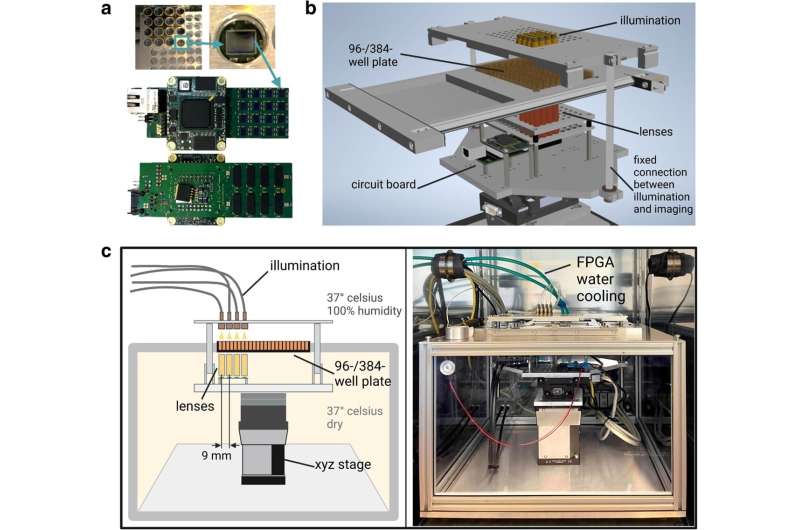This article has been reviewed according to Science X's editorial process and policies. Editors have highlighted the following attributes while ensuring the content's credibility:
fact-checked
peer-reviewed publication
proofread
Multi-lens array microscope microscope and AI enable faster migration analysis of immune cells

Immune cells fight infectious intruders, for example, or search for incipient cancers. Therefore, they are constantly migrating through the tissues of our body. But in the wrong place, immune cells like neutrophil granulocytes can cause damage. If these white blood cells infiltrate tumors, this is often associated with a poor prognosis for patients. This is why they could benefit from drugs that prevent neutrophils from migrating into tumors.
Until now, this migration has been investigated using conventional video microscopy. Researchers (University of Duisburg-Essen, Leibniz-Institut für Analytische Wissenschaften) have developed a microscope for the high throughput analysis of compounds.
With conventional video microscopy, a single camera objective observes the movement of cells under the microscope—one sample at a time. With their new microscope, scientists from the University of Duisburg-Essen (UDE) and Leibniz-Institut für Analytische Wissenschaften (ISAS) can analyze multiple samples simultaneously. The researchers present their microscope, named ComplexEye, in Nature Communications.
"If we knew how to control the migration of neutrophils, many diseases would be easier to treat," says Prof Dr. Matthias Gunzer, Director at the Institute of Experimental Immunology and Imaging (UDE) and Head of the Biospectroscopy Department at ISAS. But so far, there has been a lack of methods to further this kind of research, especially for the small, fast-moving immune cells. Now, Gunzer and his co-authors have been able to drastically increase the speed of migration analyses using ComplexEye.
60 times faster than conventional microscopes
"In our test runs, we were able to analyze the samples around 60 times faster than it would have been possible with conventional video microscopy," explain the two lead authors Zülal Cibir and Jaqueline Hassel (UDE).
In order to investigate the influence of existing compounds on the migration of neutrophils, the researchers from Essen tested around 1,000 substances from a chemical library at the Lead Discovery Center in Dortmund. For the subsequent analysis, the AI experts at ISAS programmed customized software.
Using the AI-supported ComplexEye system, within just four days, the researchers then identified 17 substances that can strongly influence the mobility of human neutrophils.
Initially, the findings are of basic scientific value, but the researchers hope that they will open up many new therapeutic options. "With a few minor adjustments, ComplexEye can also be used for other cells, for example to monitor the progression of diseases and detect early warning signs of a worsening of infections such as imminent blood poisoning," says immunologist Gunzer.
About ComplexEye
To develop ComplexEye, scientists from the Faculty of Medicine, the Department of Electrical Engineering and Information Technology at UDE and ISAS in Dortmund worked closely together.
"The challenge was to build miniaturized microscopes, make them moveable and assemble them so tightly into one system that they can record videos from each of the 384 chambers of a well plate, a common examination tray," says Dr. Reinhard Viga from the Electronic Components and Circuits division at UDE.
The electrical engineer was in charge of the technical construction of the new microscope. Like the multi-lens compound eye of a fly, ComplexEye moves under the well plate and simultaneously takes images with all its lenses every eight seconds.
The researchers then combine these images to create time-lapse sequences. Migrating cells visible in these movies are then tracked individually by AI. In the future, ComplexEye will be expanded to include additional lenses so that even more images can be captured.
More information: Zülal Cibir et al, ComplexEye: a multi-lens array microscope for high-throughput embedded immune cell migration analysis, Nature Communications (2023). DOI: 10.1038/s41467-023-43765-3

















